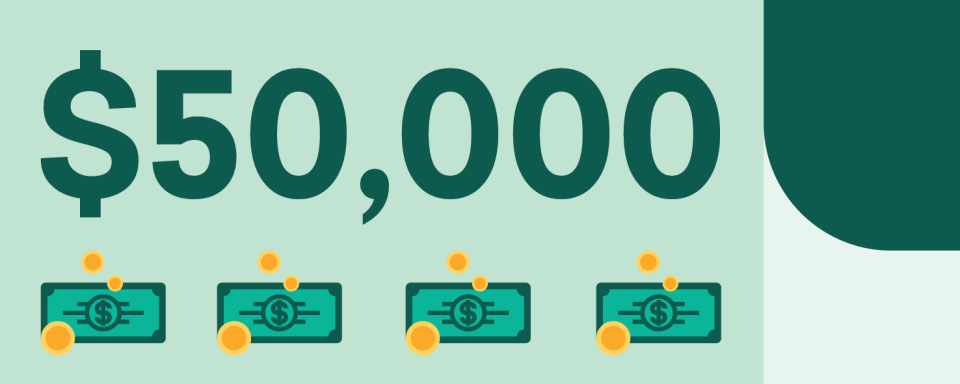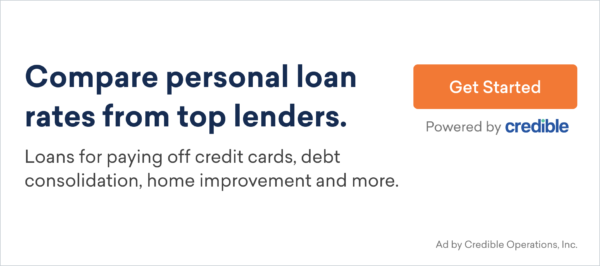How to Get a $50,000 Personal Loan Fast

Content provided by Credible. Although we do promote products from our partner lenders who compensate us for our services, all opinions are our own.
This article first appeared on the Credible blog.
If you need to cover a substantial expense, a personal loan could be a good choice. You can use a large personal loan — such as a $50,000 loan — for a wide variety of purposes, including debt consolidation, home renovation, and more.
Here’s what you should know before taking out a $50,000 loan.
Where to get a $50,000 loan
Below you’ll find some of your options when it comes to different types of personal loan lenders:
Online lenders
Online lenders can be a good source for large personal loans. They often have an easier application process than banks and credit unions and might offer lower rates.
Plus, some might even get you your loan in as little as one business day.
Credible is partnered with three online personal loan lenders that offer $50k personal loans:
LightStream offers large personal loans to borrowers with good credit. Personal loans from LightStream come with repayment terms up to seven years (up to 12 years for home improvement loans), which could make it a good choice for long-term personal loans.
SoFi loans are geared toward borrowers with good to excellent credit and are available for up to $100,000. With SoFi, you’ll also enjoy benefits such as unemployment protection and job placement assistance.
Upstart has lower credit score requirements than LightStream and SoFi, which could make it a good option if you have less-than-perfect credit. With Upstart, you can borrow $1,000 to $50,000.
You can use Credible to compare personal loan rates from multiple lenders, all in one place.
Banks
Banks typically offer interest rate discounts on personal loans — for example, you might get a discount if you already have a savings or checking account with them.
In addition, many lenders offer autopay discounts if you agree to have your loan payments automatically deducted from your checking or savings account each month.
Keep in mind: Some big banks like Chase, Bank of America, and Capital One don’t offer personal loans. But others like Citibank and Wells Fargo do.
Citibank will loan up to $50,000, although you’ll have to call the bank or visit a branch office to borrow more than $30,000. The upper limit for unsecured personal loans at Wells Fargo is $100,000.
Credit unions
Although you do have to be a member to get a loan from a credit union, many have open membership requirements that allow almost anyone to join.
Like banks, credit unions sometimes offer interest rate discounts if you already have an account with them or if you set up automatic payments.
Here are a few credit unions that offer personal loans of $50,000 or more:
Alliant Credit Union offers loans from $1,000 to $50,000 with repayment terms as long as five years. If you’re approved, you could have your money deposited the same day.
First Tech Federal Credit Union personal loans are available for up to $50,000. They also come with no origination fees or prepayment penalties.
Navy Federal Credit Union provides loans as small as $250 all the way up to $50,000 — often with same-day funding. Membership at Navy Federal Credit Union is limited to the armed forces, the Department of Defense, veterans, and family members of military veterans.
Keep in mind: Personal lending limits are often lower at credit unions than banks. Boeing Employees Credit Union doesn’t provide personal loans of more than $15,000, for example. At Teachers Federal Credit Union, the upper limit is $20,000. However, these loans could still be good choices if you can get away with borrowing less — especially since credit unions sometimes have lower loan rates compared to banks.
How to get a $50k personal loan with bad credit
Borrowing $50,000 is a significant responsibility. Because of the large amount, lenders typically have stricter eligibility criteria to qualify for a loan. This often includes meeting a minimum credit score requirement.
Keep in mind: While some lenders might be willing to lend you $50,000 if you have bad credit, you’ll likely pay a much higher interest rate to offset the lender’s risk. You could also consider secured personal loans, which require you to use an item of value (such as your car) as collateral.
Improving your credit score could help you get a loan with better terms in the future. Here are a few ways to build your credit over time:
Make all of your payments on time. Your payment history is the biggest factor that affects your credit score. If you make all of your payments on time (such as on student loans, credit cards, or utility bills), you might be able to boost your score.
Pay down debt. Your credit utilization — how much of your available credit that you’ve used — also impacts your score. Paying down existing debt (like credit card balances) will help improve your credit utilization.
Reduce your credit applications. Every time you apply for new credit and undergo a hard credit inquiry, your credit score might decrease. Be mindful of how often you apply for new credit to help maintain your credit score.
Tip: If you need a $50,000 loan quickly and don’t have the time to wait for your credit to improve, adding a cosigner to your application could improve your chances of approval. Not all personal loan lenders allow cosigners on personal loans, but some do. Having a creditworthy cosigner might also qualify you for a lower interest rate than you’d get on your own.
If you’re ready to apply for a $50,000 loan, be sure to consider both the monthly payments as well as the overall cost of the loan before you borrow. This way, you can budget for the extra expense — and keep building your credit with on-time payments.
You can estimate how much you’ll pay for a loan using Credible’s personal loan calculator.
Need a personal loan? Compare rates without affecting your credit score. 100% free!
Can you get a $50,000 loan with no credit check?
Generally, no — because of the size of a $50,000 loan, most lenders will perform a credit check to see if you qualify as well as to determine your rate and terms.
Keep in mind: While you might be able to get a small personal loan — such as a payday or pawn shop loan — without a credit check, these types of loans are almost always a bad idea because of their astronomical rates and fees. Applying for a personal loan with a cosigner or focusing on building your credit first are typically much better options for getting the money you need.
What to consider when comparing loans
If you’ve shopped around and have multiple options for taking out a $50,000 personal loan, here’s a checklist of five main factors to consider:
1. Interest rates
The interest rate charged by the lender is typically the biggest cost of borrowing money. It’s how much you pay in interest charges each year when you take out a loan, expressed as a percentage.
The shorter the loan term, the lower the interest rate offered by most lenders.
Keep in mind: You’ll have to decide if a fixed or variable rate loan is best for your situation. Not all personal loan lenders offer both, but some do.
2. Fees
Watch out for origination fees, which are taken out of your loan proceeds before you even see them.
To help you understand the impact of any additional fees and expenses over the life of your loan, lenders are required to factor them into another calculation called the annual percentage rate (APR).
Tip: Be sure to comb the fine print and ask your lender about any prepayment penalties, which are charged at the end of your loan if you decide to pay it off early. Prepayment penalties aren’t factored into your actual APR because you might not have to pay them.
3. Repayment term
How much a loan will cost to repay depends not only on the loan amount you borrow and at what interest rate, but on how long you take to repay your loan.
The longer you take, the more interest charges you’ll rack up.
Keep in mind: The shorter the repayment term, the lower the interest rate offered by most lenders. If you can afford it, choosing a shorter repayment term could reduce the amount of interest you’ll pay over time — lowering your total loan cost.
4. Monthly payment
The monthly payment is an important indicator of whether a loan will fit your budget. If it seems that the monthly payment will eat up too much of your paycheck, you can look at loans with longer repayment terms.
For example: If you stretch your payments out over seven years instead of five, you’ll make 84 payments instead of 60, so each payment will be smaller. Just remember that the longer the repayment term, the higher the interest rate and total repayment costs.
5. Total repayment costs
The bottom line when shopping for a loan is what your total repayment costs will be. Before you sign a loan contract, review the federal Truth in Lending Act (TILA) disclosure provided by your lender.
Pay special attention to these two numbers:
The finance charge: This is the cost of your loan, including interest and fees, assuming you make all your payments on time.
Total payments: This is the sum of all the payments you’ll make to pay off your loan, including the loan principal and finance charges.
Cost to repay a $50,000 personal loan
The table below shows the relationship between the loan repayment term, interest rate, monthly payment, and total interest charges.
The interest rates in the table are hypothetical, for purposes of illustration only.
Typically, the shorter the repayment term, the lower the interest rate and total interest charges, and the higher the monthly payment.
Tip: A good rule of thumb, if you’re seeking to minimize total repayment costs, is to select a loan with the biggest monthly payment and the shortest repayment term you can afford.
Using Credible’s personal loan calculator will give you an idea of what your monthly payment and total cost (including total interest) will be with a personal loan at the rates and terms available to you.
When you compare personal loan rates through Credible, you’ll get a dashboard showing that information for loans that you’re prequalified for.
Alternatives to a $50k personal loan
If you don’t qualify for a $50,000 personal loan or can only get a loan with a high interest rate, consider these other options:
Home equity loan: With this type of loan, you borrow against your home’s equity. Home equity loans often have longer repayment terms and lower interest rates than personal loans, mainly because your home secures the loan. Just keep in mind that you could lose your home if you fall behind on your payments.
Home equity line of credit (HELOC): A HELOC is a revolving line of credit that you can repeatedly draw from and pay off — similar to a credit card. Like a home equity loan, a HELOC uses the equity in your home as collateral — which could also put your home at risk if you can’t make your payments.
Be careful: If you decide to take out a home equity loan or HELOC, be sure to borrow only what you need and can afford to pay back. You don’t want to end up losing your home if you can’t make your payments in the future.
About the author: Kat Tretina is a freelance writer who covers everything from student loans to personal loans to mortgages. Her work has appeared in publications like the Huffington Post, Money Magazine, MarketWatch, Business Insider, and more.

 money
money 

